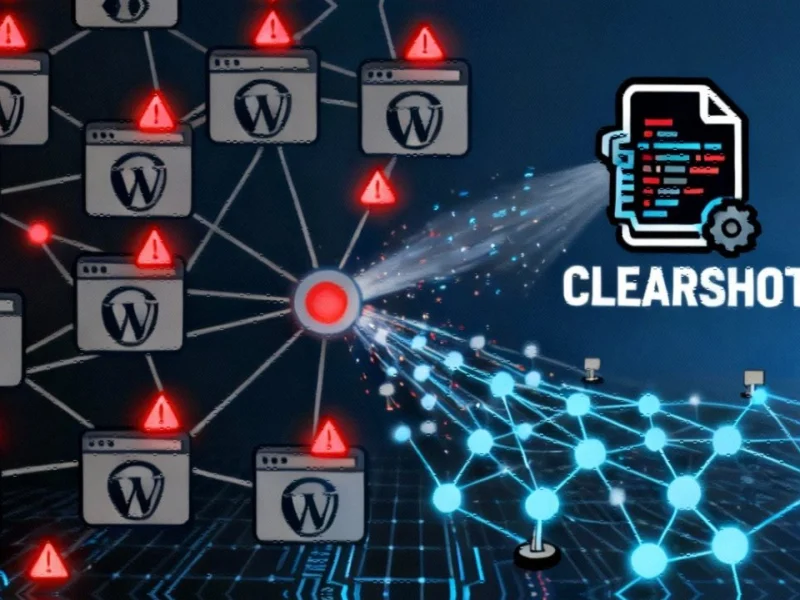Massive WordPress Campaign Exploits Blockchain Resilience
In a sophisticated malware operation that highlights evolving cyber threats, over 14,000 WordPress websites were compromised and transformed into distribution platforms for malicious payloads. Google’s Threat Intelligence Group (GTIG) revealed that the campaign, attributed to threat actor UNC5142, leveraged blockchain technology to create a resilient infrastructure that proved difficult to detect and dismantle.
The campaign, which ran from late 2023 until July 2025, represents a significant shift in how attackers are approaching malware distribution infrastructure. Unlike traditional methods that rely on centralized servers, UNC5142 utilized public blockchain networks, particularly the BNB chain, to host components of their attack chain.
The CLEARSHOT Downloader: A Multi-Stage Attack Framework
At the heart of the operation was the CLEARSHOT JavaScript downloader, which researchers described as a sophisticated multi-stage framework. Once attackers compromised vulnerable WordPress sites—typically through flawed plugins, theme files, or database vulnerabilities—they implanted CLEARSHOT to serve as the initial infection vector.
“The indiscriminate targeting of WordPress vulnerabilities demonstrates how attackers are casting wide nets to maximize their reach,” explained a security analyst familiar with recent technology threats. “The use of blockchain adds an unprecedented layer of resilience to their operations.”
Blockchain Integration: The Game-Changer in Malware Distribution
What makes this campaign particularly noteworthy is its innovative use of blockchain technology. By hosting stage-two payloads on the public blockchain, UNC5142 created an infrastructure that traditional takedown methods couldn’t effectively dismantle.
“Network-based protection mechanisms are more difficult to implement for Web3 traffic compared to traditional web traffic given the lack of use of traditional URLs,” the GTIG report stated. “Seizure and takedown operations are also hindered given the immutability of the blockchain.”
This approach represents a significant evolution in how threat actors are adapting to industry developments in cybersecurity defenses. The immutable nature of blockchain means that once malicious code is deployed, it remains accessible indefinitely, creating persistent threats that conventional security measures struggle to address.
The ClickFix Social Engineering Tactic
The campaign’s distribution mechanism relied heavily on social engineering through what researchers dubbed the “ClickFix” tactic. After the initial compromise, victims were directed to landing pages—typically hosted on Cloudflare .dev domains—that presented convincing prompts urging users to copy and paste commands into their system’s Run program (Windows) or Terminal (Mac).
These landing pages were retrieved in encrypted format from external servers, adding another layer of obfuscation to the attack chain. The technique preyed on user trust and familiarity with system commands, demonstrating how related innovations in social engineering continue to evolve alongside technical attack methods.
UNC5142: An Evolving Threat Landscape
While UNC5142’s operations appeared to cease in late July 2025, security researchers caution that this may represent an evolution rather than a cessation of activities. Google’s analysis suggests the group has likely improved their obfuscation techniques and continues to operate, potentially using different methods or targeting different platforms.
The group’s success in compromising thousands of websites highlights ongoing challenges in market trends for web security. As one security professional noted, “The scale of this campaign demonstrates that despite advances in security technology, fundamental vulnerabilities in popular platforms continue to provide fertile ground for attackers.”
This incident serves as a critical reminder for organizations to maintain rigorous security practices, particularly regarding third-party plugins and themes. The continuing evolution of threats underscores the importance of comprehensive security strategies that address both technical vulnerabilities and human factors in cybersecurity defense.
For more detailed analysis of how these industry developments are affecting security protocols across various sectors, including how organizations are adapting to these emerging threats, security professionals are closely monitoring the evolving landscape of digital security challenges.
This article aggregates information from publicly available sources. All trademarks and copyrights belong to their respective owners.



